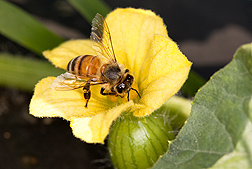This page has been archived and is being provided for reference purposes only. The page is no longer being updated, and therefore, links on the page may be invalid.
Bees Exposed to Fungicide More Vulnerable to Nosema Parasite
By Kim KaplanJuly 24, 2013
WASHINGTON—Honey bees that consume pollen that contains amounts of commonly used fungicides at levels too low to cause the bee's death still may leave them more susceptible to infection by a gut parasite, according to U.S. Department of Agriculture (USDA) and University of Maryland research published today in PLOS ONE.
This research complements other recent USDA research into bees, including a comprehensive scientific report on honey bee health issued in May that found multiple factors play a role in honey bee colony declines, including parasites and disease, genetics, poor nutrition and pesticide exposure. The May report specifically highlighted the need for additional research to determine risks presented by pesticides, along with the need for improved collaboration and information sharing.
Researchers from the university and USDA's Agricultural Research Service (ARS) collected pollen samples from honey bees pollinating apples, watermelons, pumpkins, cucumbers, blueberries or cranberries. The scientists then analyzed the pollen to determine how much fungicide, insecticide, miticide and/or herbicide the bees were exposed to while pollinating each of the six crops.
In many cases, the pollen that bees brought back came primarily from plants other than the targeted crop. Some pollen samples contained very few pesticides, but the average number seen in a pollen sample was nine different pesticides, which could include insecticides, herbicides, miticides and fungicides.
Fungicides were the most frequently found chemical substances in the pollen samples. The most common was the fungicide chlorothalonil, which is widely used on apples and other crops. The most common miticide was fluvalinate, which beekeepers use to control varroa mites. Neonicotinoid insecticides were only found in pollen from bees foraging on apples.
"Honey bees that were fed pollen that contained the fungicide chlorothalonil and was collected at the hive entrance were almost three times more likely to become infected when exposed to the parasite Nosema, compared with control bees," explained study author Jeff Pettis, research leader of the Bee Research Laboratory in Beltsville, Md. The lab is part of ARS, USDA's chief intramural scientific research agency.
The fungicide pyraclostrobin, which was found less frequently in the pollen samples, also increased bees' susceptibility to Nosema infection.
"Our study highlights the need to closely look at fungicides and bee safety, as fungicides currently are considered safe and can be sprayed during the bloom on many crops," said co-author Dennis vanEngelsdorp with the University of Maryland. "We also need to better understand how pesticides are getting into the hive. Clearly it is not just from collecting pollen from the crops that bees are being used to pollinate."
These findings provide new information useful in understanding the myriad of problems affecting honey bees in the United States, including colony collapse disorder, dwindling honey bee colonies, and other health problems in managed bee colonies, Pettis added.
One unexpected finding was that honey bees collected relatively little pollen from blueberry and cranberry plants, which are both crops that originated in the New World. Despite this lack of pollen collection, researchers know that bees do pollinate these plants. Honey bees were brought to North America from Europe along with Old World crops such as almonds and apples, which co-evolved with honey bees as their pollinators.

